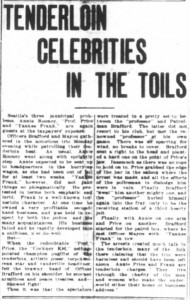TENDERLOIN CELEBRITIES IN THE TOILS
From the desk of Steve Willis, Central Library Services Program Manager of the Washington State Library:
Found at random in the Sept. 12, 1905 issue of the always entertaining Seattle Star:
TENDERLOIN CELEBRITIES IN THE TOILS
Seattle’s three municipal problems, Annie Rooney, “Prof.” Price and “Yankee Frank,” are again guests at the taxpayers’ expense.
Officers Brafford and Mayou gathered in the notorious trio Monday evening while patrolling their tenderloin beat. As usual, Annie Rooney went along with sprightly step. Annie expected to be sent up to headquarters in the hurry-up wagon, as she had been out of jail for at least two weeks. “Yankee Frank,” however, did not take things so phlegmatically. He protested in terms both emphatic and lurid. Frank is a well-known tenderloin character. At one time he owned a very profitable second-hand business and was held in respect by both the police and his many acquaintances. His business failed and he rapidly developed into a shiftless n’er-do-well.
But–
When the redoubtable “Prof.” Price, the “Cockney Kid,” self-appointed champion pugilist of the tenderloin, artistic poser, terpsichorean star and vaudeville headliner felt the brawney hand of Officer Brafford on his shoulder, he scorned armitices and peace treaties, and–
Showed fight!
Then it was that the spectators were treated to a pretty set-to between the “professor” and Patrolman Brafford. The latter did not resort to his club, but met the reknowned “professor” at his own game. There was no sparring for wind, no breaks to cover. Brafford sent a right to the head and planted a hard one on the point of Price’s jaw. Inasmuch as there was no rope to hold on to, Price grabbed the edge of the bar in the saloon where the arrest was made, and all the efforts of the policeman to dislodge him were in vain. Finally Brafford “swat” him another mighty one, and the “professor” hurled himself into the fray, only to be the receiving station of a third hearty jolt.
Finally, with Annie on one arm and Price on another, Brafford started for the patrol box, where he met Officer Mayou with “Yankee Frank” in tow.
The arrests created much talk in the tenderloin, many of the folk there claiming that the trio were harmless and should have been left alone. Annie, Price and Frank are tenderloin charges. They live through the charity of the men and women who make the underworld either their home or business address.
Annie Rooney was no stranger to Seattle headline writers. Born around 1868-1870 in New York, she was raised in Michigan as the second daughter of a wealthy doctor. She was said to have attended the Boston Conservatory of Music and was regarded as something of a musical prodigy. In the early 1880s she toured the Massachusetts entertainment circuit as one of the feature acts for the Bennett & Moulton’s Juvenile Opera Company under her birth name, Florence Story.
When Florence was about 16 she fell in love with a fire-eater and variety theater entertainer named Del Bartino. The two married, much to the disapproval of her parents, and headed to Seattle in 1886. They opened in box house theaters, which is to say they were saloons with a space dedicated for shows and other activities, to put it politely. The Bartinos worked with the legendary theater man John Cort, as well as Tacoma’s “Boss Sport,” Harry Morgan.
In Eugene Clinton Elliott’s A History of Variety-Vaudeville in Seattle from the Beginning to 1914, a playbill for Morgan’s Theater is reproduced, dated October 1, 1887. Florence is now called Flora Story, “a dashing little artist” and “the queen of the African harp.”
Everything came apart for Florence in 1889. Seattle’s business district burned down, wiping out every theater in town. And her marriage to Bartino crumbled. According to legend, she dressed as a boy and ran away to sea for a time. When she returned to Seattle she had become Annie Rooney, notorious drunk.
She might have borrowed the name from the title of a popular song of the era. She became such a celebrity problem in Seattle’s tenderloin district that at one point in March, 1903, the local police put her on a steamer with a one-way ticket to Whatcom.
But she came back.
In November, 1903, while in an extended stay at Western State Hospital, Annie had the experience of reading her obituary in several newspapers. “Nobody,” said WSH Superintendent C.M. Parks, “enjoyed those stories of her death more than did Annie Rooney herself.”
By 1905, when the above article was published, Seattle’s Tenderloin district was being pushed south as the downtown real estate became more valuable with the expansion of the city. The “Golden Age of Vice,” and the reign of characters like Annie Rooney, were coming to an end.